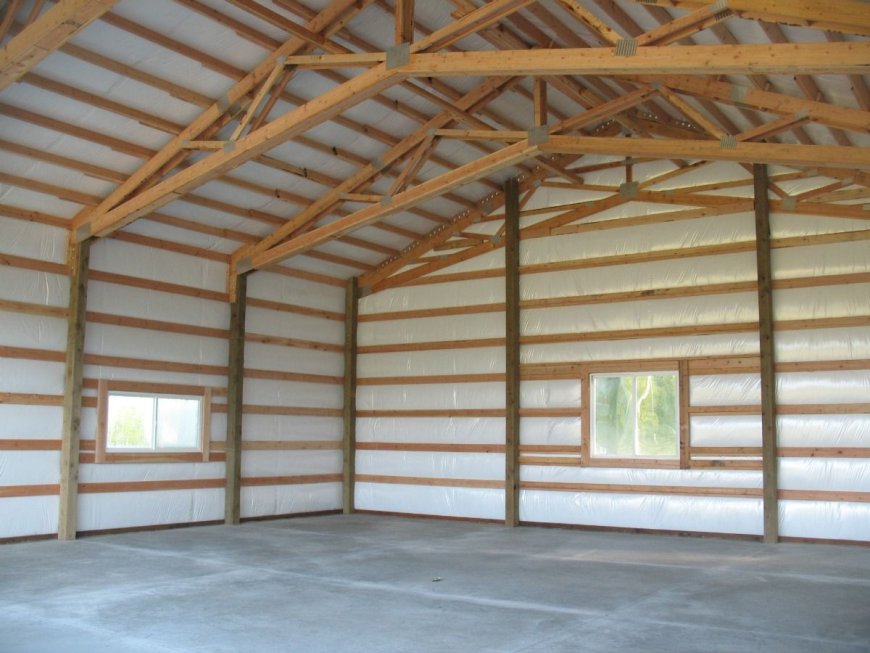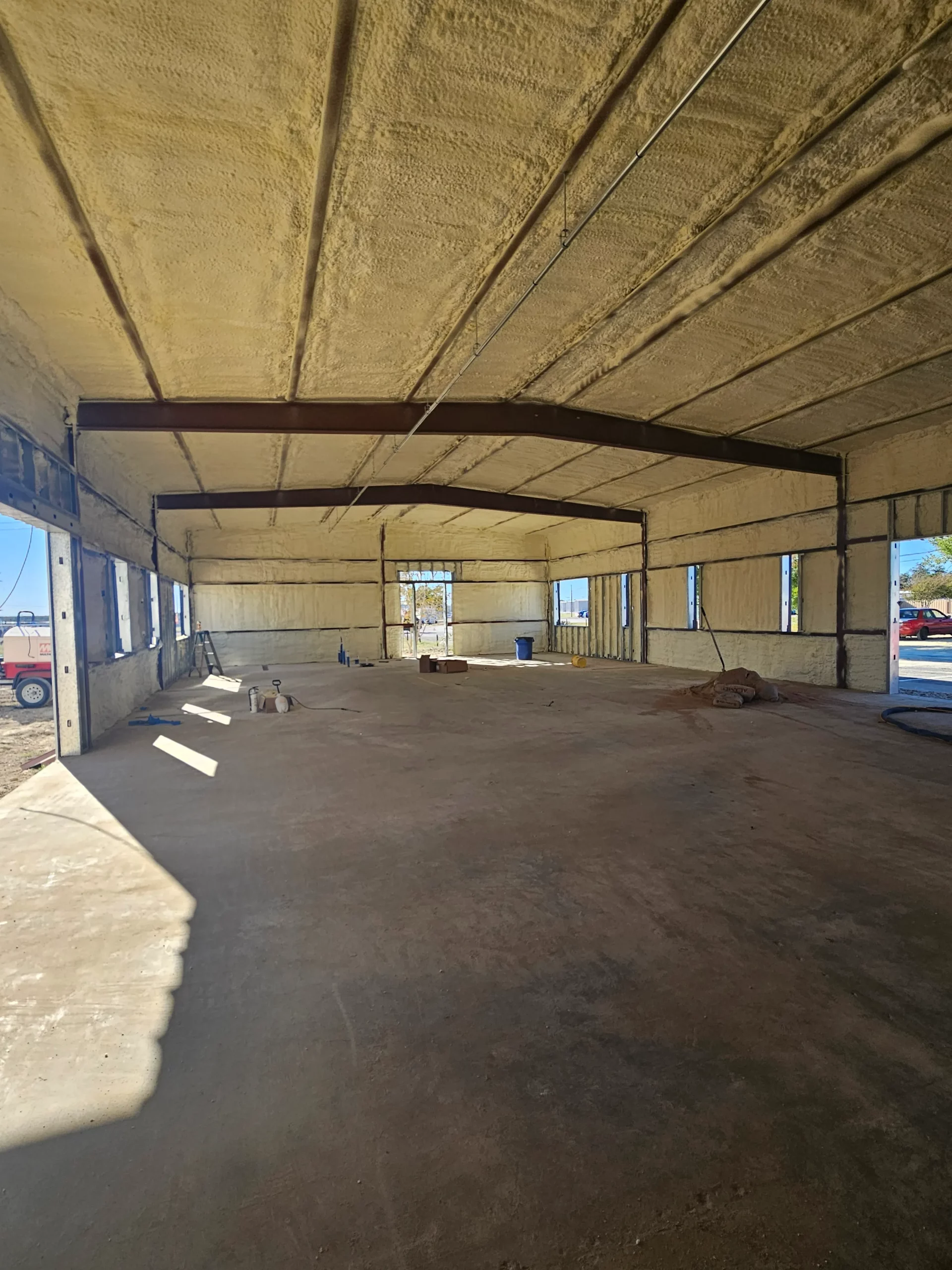Best Uses of Spray Foam for Pole Barn Insulation

Spray foam insulation offers key advantages for insulating pole barns used in agriculture, equipment storage, or workspace applications. Its performance in sealing air gaps, managing moisture, and improving energy efficiency makes it a strong alternative to traditional materials.
This article outlines the most effective uses of spray foam in pole barn construction and retrofit projects. You'll learn where it works best, how it compares to other insulation types, and what to consider when deciding between professional and DIY installation.
Choosing the Right Type of Spray Foam for Pole Barns
Spray foam comes in two main types: closed-cell and open-cell. Each has different characteristics suited to specific areas within a pole barn.
Closed-Cell Spray Foam
Closed-cell spray foam is dense, rigid, and provides both high insulation value and structural support. It adheres tightly to surfaces and resists water, making it ideal for barn walls, ceilings, and metal surfaces. The typical R-value is between R-6.5 and R-7 per inch, which means less material is needed to achieve strong thermal resistance. It also acts as a vapor barrier, reducing the chance of moisture buildup.
Open-Cell Spray Foam
Open-cell foam is lighter, more flexible, and has a lower R-value of around R-3.5 to R-4 per inch. It offers strong air-sealing performance but allows some vapor permeability. While its less water-resistant, it can be used effectively in interior partitions or conditioned barn spaces where moisture is not a concern.
Areas of a Pole Barn Where Spray Foam Performs Best
Spray foam adapts to various structural components of a pole barn. Its expanding nature allows it to fill gaps and seal uneven surfaces, especially common in agricultural buildings.
Roof and Ceiling Cavities
Metal roofs are prone to air leaks and temperature swings. Applying spray foam to the underside of the roof panels creates an airtight layer that reduces heat transfer and prevents condensation. This is especially useful in barns used year-round or in extreme climates, where thermal stability is critical.
Wall Cavities and Framing Gaps
Spray foam forms a tight bond to wood and metal framing, creating a continuous thermal barrier. This helps eliminate drafts, reduce sound transmission, and keep the interior space more comfortable. The insulation fills odd-sized gaps and voids that are hard to reach with fiberglass batts.
Floor Edges and Slab Perimeters
In barns with concrete slabs, heat often escapes through the edges. Applying closed-cell spray foam along the perimeter minimizes heat loss and improves energy efficiency. For barns with radiant heating, this approach supports more consistent floor temperatures and reduces energy waste.
Moisture Control and Condensation Prevention
Moisture is a common issue in pole barns, especially those with metal exteriors. When warm, moist air meets a cold metal surface, condensation occurs. Over time, this can lead to mold, corrosion, or rot in framing members.
Spray foam prevents this by increasing the temperature of interior surfaces and reducing air infiltration. Closed-cell foam also functions as a vapor barrier, which means moisture-laden air can't pass through and reach colder surfaces. This reduces the risk of condensation forming in attics, behind walls, or along ceilings.
Spray Foam vs. Traditional Insulation in Pole Barns
Comparing spray foam to fiberglass and reflective foil shows its performance advantages in pole barn settings.
|
Feature |
Spray Foam |
Fiberglass Batts |
Reflective Foil |
|---|---|---|---|
|
Air Sealing |
Excellent |
Poor |
Limited |
|
Moisture Resistance |
High (Closed-Cell) |
Low |
Moderate |
|
Structural Strength |
Adds rigidity |
None |
None |
|
Installation Surface Compatibility |
Uneven/curved surfaces |
Flat surfaces only |
Flat surfaces only |
Spray foam's ability to seal air leaks and resist moisture gives it a long-term advantage, especially in pole barns exposed to fluctuating temperatures or high humidity. While fiberglass and foil can be cheaper initially, they often lead to performance issues when exposed to condensation or air leaks.
Installation: Professional vs. DIY
Spray foam insulation requires precision during application. While DIY kits are available, theyre typically better suited for small jobs or touch-ups.
Professional Application
Licensed installers use specialized equipment that ensures consistent spray patterns and foam ratios. This helps avoid issues like underexpansion or poor adhesion. For large barns or buildings where insulation must meet code, professional service ensures even coverage and compliance with safety standards such as thermal barriers and ignition protection.
DIY Spray Foam Insulation
DIY kits can be used for insulating small areas like door gaps, rim joists, or patching. However, they require protective gear, careful handling, and an understanding of how to apply the foam without overfilling or missing spots. Improper application can lead to poor insulation performance or unsafe conditions from off-ratio mixing.
Considerations for Long-Term Energy Efficiency
Spray foam supports energy-efficient barn insulation by reducing air leaks, improving R-values, and helping HVAC systems operate more efficiently. To maximize these benefits, its important to integrate other building components properly.
Ensure that the pole barn has adequate ventilation, especially at the ridge and eaves. This prevents trapped heat or moisture buildup. For barns used as workshops or commercial spaces, combining closed-cell foam with conditioned air systems improves temperature control and lowers operating costs over time.
Common Questions
Is closed-cell spray foam worth the extra cost in a pole barn?
Yes. Its higher R-value, water resistance, and structural reinforcement justify the cost, especially in barns exposed to moisture, wind, or heavy use.
Can spray foam be applied directly to metal siding?
Yes, closed-cell foam adheres well to clean metal surfaces. It creates a seamless insulation layer that reduces thermal bridging and moisture problems.
What R-value should I aim for in a pole barn?
Aim for R-13 to R-21 in walls and R-30 or more in ceilings, depending on climate zone. Closed-cell foam achieves these values with less thickness than other materials.
Will spray foam prevent condensation on metal roofs?
Yes. It reduces the temperature difference that causes condensation and blocks humid interior air from reaching cold surfaces.
Conclusion
Spray foam delivers strong performance for pole barn insulation by reducing air leakage, managing moisture, and improving interior temperature consistency. Its versatility allows it to be applied to various areas of the barnwalls, ceilings, and slab edgeswithout requiring traditional framing adjustments.
For property owners or contractors seeking a durable, low-maintenance solution, best spray foam insulation supports long-term energy savings and moisture protection. When applied correctly, it extends the useful life of a pole barn and keeps interior conditions stable in all seasons.
FAQs
Can spray foam be used with radiant heating systems in pole barns? Yes. It insulates slab edges effectively, which helps radiant heat stay within the barn and operate more efficiently.
Does spray foam insulation attract pests or rodents? No. Spray foam doesn't provide nesting material or food for pests. It also blocks common entry points.
How long does spray foam insulation last in a pole barn? Properly installed spray foam can last 2030 years or more without significant degradation.
Will spray foam make a pole barn airtight? It significantly reduces air infiltration, especially in joints and seams. Mechanical ventilation may still be necessary to maintain air quality.
What safety gear is required for DIY spray foam installation? Use protective eyewear, gloves, a respirator, and a full-body suit to avoid chemical exposure during application.

Reviewer: Maria Lopez reviewed the article and brought 12 years of insulation industry experience to improve the guidance. Practical tips were added, and the content was made clearer and more useful for contractors working in the field every day.









































